Southern charm
On windswept Otago Peninsula with grand views out to the Southern Ocean sits a nineteenth century mansion surrounded by one of the world’s most beautiful gardens.
It is one of New Zealand’s top accumulated over thirty years’ tourist attractions with a fascinating history and fabulous architecture, not to mention the views. But, for many of us, a pilgrimage to Larnach Castle is all about the garden - a paradise for plant lovers.
The creator of this world renowned garden is Margaret Barker, who has owned Larnach Castle for nearly fifty years. When she and her late husband arrived in 1967, the garden was derelict and overgrown, but Margaret had a vision. In the process of realising that dream she has become one of New Zealand’s most esteemed plantswomen. In her book, “My Home My Castle” she writes candidly about her journey. It’s an inspiring read.
Behind every great garden is an expert maintenance team. Larnach Castle’s head gardener is Fiona Eadie, a plant lover who confesses she has turned her passion into a career. Starting with a botany degree from Otago University, Fiona has accumulated over thirty years’ experience working closely with plants. For eleven of those years she managed Oratia Native Plant Nursery in Auckland, which led to a best selling book. Fiona’s “100 Best Native Plants for New Zealand Gardens” is now onto its third fully revised edition.
New Zealand plants remain her number one passion and they’re plentiful at Larnach Castle, where they intermingle with plants from other places. “When I first arrived 15 years ago the only exotic plant I knew was Pinus radiata,” she laughs. “Dealing with herbaceous perennials was completely alien to me, but I do love a challenge!”
Like any garden, this one is constantly evolving and changing. “It has to,” says Fiona “because plants never stop growing and you cannot have a good garden without maintenance.” While she works closely with Margaret on design and planting decisions, Fiona’s key role, with her team of three full time gardeners, is to keep the vast 7 acre garden maintained to the highest possible standard.
Her working week is filled to capacity with all things horticultural. When she’s not elbow deep in the gardens at Larnach Castle, she’s writing about plants, talking about plants or teaching about plants. So she makes no apologies for her lack of garden at home. “We were determined to find a house with a small section, which wasn’t as easy as you might think!” Most Dunedin houses come with generously proportioned gardens.
Fiona refuels on weekends by getting close to nature - but not in her garden. While others unwind in their back yards, she and her partner head for their ‘chill spot’,a five hectare escape in Central Otago they call ‘The Paddock’. Here they are slowly planting a minimalist landscape to complement their rammed earth house which mimics the earthy tones of the Otago wilderness. “It’s important to us that anything we plant here melds into the environment,” explains Fiona. “It’s about the least possible visual impact and the least possible work.”
As a scientist and an educator, Fiona prides herself in keeping up with the latest research. These days, it’s our relationship with the soil that really fuels her fire. “Fluffy soil is a thing of the past!” she asserts. She’s anti digging, explaining that this dries the soil out too fast and destroys its structure. “Soil needs organic matter, we nearly all know that now, but not too much; more is not better,” she says. “Ideally it should come from the top as an organic mulch leaving the soil organisms to bring it into the soil itself. They have been doing it for a few hundred thousand years and know what they are doing! Mulch also helps lock in moisture, block weeds, feeds the all-important soil organisms and provides nutrients to plants - win win!”
Fiona says our plants will love us if we first apply a layer of compost, then newspaper (for weed control) then a coarse organic mulch. “Leave clay where it is supposed to be, under your topsoil,” she adds. “It’s excellent for holding water and nutrients and your plants expect it to be there.”
As two highly experienced gardeners with contrasting horticultural backgrounds, it’s natural that Fiona and Margaret wouldn’t always agree. What they share is a love of plants and a confident common sense attitude. “One thing we are both quite strong on is the importance of an occasional slash and burn,” says Fiona. “Sometimes you need to clear an entire area and start over again.” She says it’s easy to lose perspective when you’re surrounded by mature trees and shrubs that should really make way for something new. “Remind yourself that plants grow,” she advises. “And don’t be scared! Be really choosy about what you want to keep and then start culling. As much as I love them, they are just plants!”
A badly pruned plant, for example, can be near impossible to fix. “It is better to replace it with a new one and prune it better next time. Or ideally, choose trees carefully so they only grow to the height you want. Unless you like pruning.”
Fiona herself loves pruning. “It’s just one of the things I do without thinking.” She agrees it helps that as a trained botanist she can’t help but think about things from the plants perspective.
Creating topiary shapes and accentuating plants natural forms is one of the ways that Fiona keeps the garden looking interesting throughout the year. Form is too easily overlooked in the quest for colour, she feels. Texture is another thing she thinks we gardeners could consider more often when choosing our plants. One example of this is Margaret’s clever pairing of Ligularia (Farfugium) ‘Britt Marie Crawford’ with bronze Queen Anne’s Lace, both plants sharing the same colour but one with big round leaves and the other fine and lacy.
For anyone looking for inspiration, Larnach Castle is a showcase of stunning plant combinations. I visited in early December when the Laburnum arch, expertly trained and pruned by Fiona, was in glorious golden bloom, the rock garden was brimming with fascinating flora and the dramatic South Seas garden took my breath away. Here, the bold forms of rocks, aloes and closely clipped evergreens are repeated amid low carpeting groundcovers. Shimmering grasses, both native and exotic, add movement and texture, while masses of rusty red Gazania ‘Takatu Red’ make a striking colour accent.
The idea for the South Seas Garden sprung from Margaret’s special interest in Gondwana plants - New Zealand natives and their Southern Hemisphere cousins including plants from our sub-Antarctic Islands, Africa, Australia and South America. Her search for planting ideas has
seen her climb mountains in Lord Howe Islands, Tasmania, Chile and Argentina. No wonder the gardens of Larnach Castle are so rich in botanical diversity with a new delight around every corner.
Find out more at www.larnachcastle.co.nz
19-Jan-2017
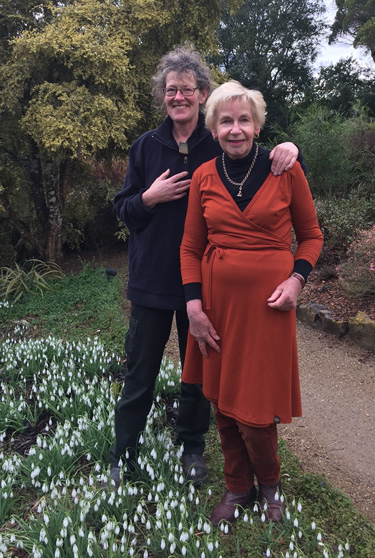
Fiona Eadie (left) with Margaret Barker
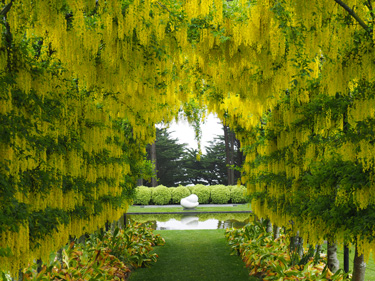
The laburnum blooms in late spring.
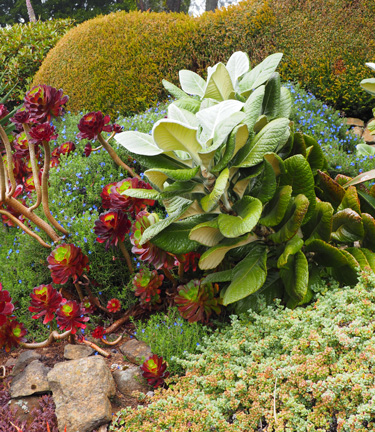
Bold leafed Oldenburgia grandis is one of the treasures in the South Seas garden
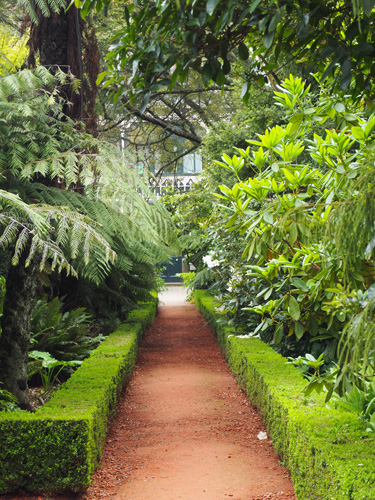
NZ natives mingle seamlessly with plants from other places
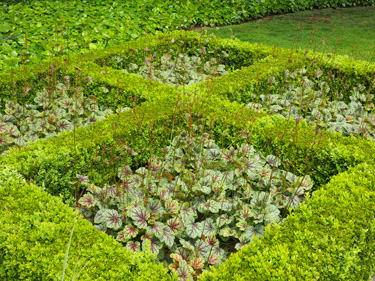
A formal box parterre with Heuchera 'Green Spice'


